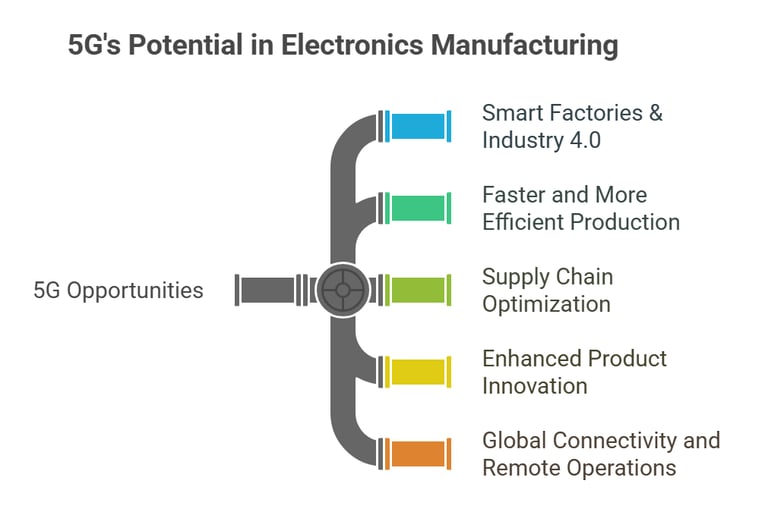5G’s Impact on Electronics Manufacturing: Opportunities and Challenges
The arrival of 5G technology is changing the game across industries, and electronics manufacturing is no exception. With ultra-fast speeds, near-zero latency, and the ability to connect millions of devices simultaneously, 5G is paving the way for smarter, more efficient production systems.
2/16/20254 min read


The arrival of 5G technology is changing the game across industries, and electronics manufacturing is no exception. With ultra-fast speeds, near-zero latency, and the ability to connect millions of devices simultaneously, 5G is paving the way for smarter, more efficient production systems. For decision-makers and designers in electronics product development, this shift is both exciting and daunting.
On the one hand, 5G opens doors to innovative product designs, faster production cycles, and enhanced supply chain management. On the other hand, it brings challenges such as high implementation costs, security risks, and the need for workforce upskilling. Understanding these factors is key to staying ahead in an increasingly competitive market.
Let’s dive into how 5G is shaping the future of electronics manufacturing, exploring both the opportunities and the challenges it presents.
Opportunities Created by 5G in Electronics Manufacturing
1. Smart Factories & Industry 4.0
The concept of Industry 4.0, where factories are connected through advanced automation, IoT, and AI, is finally becoming a reality thanks to 5G. Unlike previous wireless technologies, 5G offers ultra-low latency and high bandwidth, making real-time machine communication seamless.
Predictive Maintenance: With 5G, factories can deploy IoT sensors that monitor equipment health in real time, preventing unexpected breakdowns and costly downtime.
Automation & Robotics: High-speed, low-latency communication allows robots to work collaboratively on production lines, increasing efficiency and reducing human error.
AI-Driven Quality Control: AI-powered cameras and sensors can analyze products at lightning speed, catching defects before they make it to the next stage of production.
2. Faster and More Efficient Production
Time-to-market is a critical factor in electronics manufacturing. 5G enhances production speed by enabling better coordination between different parts of the manufacturing process.
Edge Computing for Instant Processing: Instead of relying on cloud servers, 5G enables edge computing, allowing devices to process data on-site with minimal delay.
Augmented Reality (AR) for Design & Assembly: 5G-powered AR applications assist in prototyping, assembly, and training by providing real-time, interactive instructions to workers and engineers.
Remote Control of Equipment: 5G enables technicians to operate machinery remotely, reducing the need for on-site intervention and improving safety.
3. Supply Chain Optimization
In today’s globalized world, supply chain disruptions can cause massive losses. 5G brings greater visibility and efficiency to supply chain management.
Real-Time Tracking: Smart tracking of raw materials and components ensures better inventory management and reduces delays.
Automated Warehousing: 5G-powered autonomous robots can streamline inventory sorting, picking, and packaging with extreme precision.
Digital Twins: Manufacturers can create virtual replicas of their supply chain to simulate different scenarios and optimize logistics strategies.
4. Enhanced Product Innovation
5G is not just revolutionizing manufacturing processes but also opening new doors for product innovation. As designers and developers, you now have the tools to create cutting-edge devices that weren’t possible before.
Next-Gen Consumer Electronics: From 5G-enabled smart glasses to ultra-fast mobile devices, the possibilities are endless.
IoT-Powered Devices: With 5G, smart home and industrial IoT products can operate with higher efficiency and reliability.
Wearables & Healthcare Tech: The healthcare industry is seeing a surge in wearable devices that provide real-time monitoring thanks to 5G’s connectivity.
5. Global Connectivity and Remote Operations
The ability to manage factories and production lines remotely is a game-changer, especially in the post-pandemic world where flexibility is key.
Remote Monitoring & Maintenance: 5G allows engineers to troubleshoot and maintain equipment from anywhere, reducing downtime.
Cross-Border Manufacturing Synergy: Companies can synchronize operations across multiple countries in real time, optimizing global manufacturing strategies.


Challenges and Considerations
While the benefits of 5G are undeniable, integrating this technology into electronics manufacturing comes with hurdles. Let’s examine the key challenges and how to navigate them.
1. Infrastructure and Implementation Costs
Upgrading to 5G-ready infrastructure is a significant investment, particularly for manufacturers still reliant on older systems.
Network Upgrades: Companies need to install 5G-compatible sensors, routers, and other connectivity hardware.
High Initial Costs: The cost of transitioning to a fully 5G-enabled factory can be steep, making ROI a critical factor for decision-makers.
Longer Implementation Time: Unlike software updates, physical infrastructure changes take time, which may cause temporary disruptions.
2. Supply Chain Disruptions
While 5G enhances supply chain efficiency, it also introduces new dependencies that can create challenges.
Chip Shortages: The demand for 5G-enabled components is rising, leading to potential supply shortages.
Dependence on Telecom Providers: The rollout of 5G networks varies across regions, which may delay full adoption in certain markets.
3. Security and Data Privacy Risks
The more connected your factory is, the more vulnerable it becomes to cyber threats.
Higher Exposure to Cyberattacks: With 5G linking multiple devices, a single breach can impact an entire operation.
Data Privacy Concerns: Protecting sensitive product data and customer information becomes more challenging.
Regulatory Compliance: Companies must ensure compliance with local and international data protection regulations.
4. Skills Gap and Workforce Training
Adopting 5G means factories need skilled personnel who can operate and maintain the new technology.
Upskilling Employees: Technicians, engineers, and managers must learn how to work with 5G-powered systems.
Workforce Resistance: Some employees may resist automation and digital transformation, requiring change management strategies.
5. Regulatory and Standardization Issues
Since 5G is still evolving, manufacturers must navigate regulatory challenges.
Varying Standards Across Countries: Compliance requirements differ globally, complicating international operations.
Government Restrictions: Some governments impose restrictions on 5G equipment providers, affecting supply chains.
Future Outlook: How Manufacturers Can Adapt
To stay competitive, electronics manufacturers must take proactive steps in adapting to 5G technology. Here’s what you can do:
Invest in Scalable 5G Infrastructure: Start with small, incremental upgrades to assess feasibility and ROI before full deployment.
Partner with Telecom Providers: Collaborate with 5G network providers to ensure stable and secure connectivity.
Upskill Your Workforce: Implement training programs to equip employees with the necessary skills to operate 5G-enabled systems.
Strengthen Cybersecurity Measures: Invest in robust security protocols to protect connected devices and data.
Leverage AI & IoT for Maximum Efficiency: Combine 5G with AI and IoT to unlock new levels of automation and predictive analytics.
Conclusion
5G is transforming electronics manufacturing in ways that were once considered futuristic. From enabling smarter factories to optimizing supply chains and driving product innovation, the potential is immense. However, manufacturers must navigate challenges like high costs, security risks, and workforce adaptation to make the most of this technology.
For designers and decision-makers in electronics product development, the key is to embrace 5G strategically. By taking a phased approach, investing in the right technologies, and upskilling teams, companies can not only stay competitive but also lead the charge in this new era of manufacturing.
The 5G revolution is here—the question is, how will you harness its power for your business?
